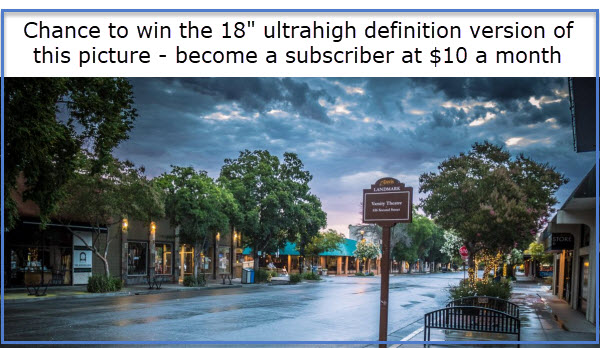 An ominous article appeared in the San Francisco Chronicle this weekend: “Development of market-rate housing in San Francisco will slow to a trickle in 2019, because a combination of higher construction costs, escalating fees, a softening market and increased interest rates has persuaded many builders to wait on the sidelines.”
An ominous article appeared in the San Francisco Chronicle this weekend: “Development of market-rate housing in San Francisco will slow to a trickle in 2019, because a combination of higher construction costs, escalating fees, a softening market and increased interest rates has persuaded many builders to wait on the sidelines.”
Industry analysts warned that development is not going to happen. Sean Keighran, president of the Residential Builders Association, which represents developers and contractors told the paper, “There are four strikes, and you only get three. It’s hard to foresee a rosy path forward.”
It is just the latest sign that the market is slowing down. But while that might seem like good news – given the lack of affordable housing, it is not.
In San Francisco, the price of single family home peaked in February 2017 at $1.7 million, the 15 percent drop to $1.44 million still puts the cost out of reach for most people, but even worse, the falling market is sufficient to have a chilling effect.
“Nobody buys land and develops in a downward market,” Mr. Keighran said. “Our guys stopped buying sites a year and a half ago.”
For those impacted by the housing crisis at a statewide level, that is not good news as more supply is viewed by many as the key to solving that crisis.
Construction costs continue to be a huge problem for the market.
That does not bode well for Davis. Davis will be looking toward mixed-use and redevelopment over the next decade as its primary means to addressing housing issues. With rising construction costs, that could put a damper on the market.
that could put a damper on the market.
One possible location for housing could be the Davis Downtown. But a pro forma by BAE looked at costs and expected returns and concluded: “These results indicate that under current conditions, it will be very difficult for developers to undertake projects similar to the prototype projects, with a few exceptions.”
BAE concludes that “development feasibility in Downtown Davis is challenging under current conditions.”
The takeaway is that “developers undertaking speculative real estate development projects in Downtown Davis face unique challenges, including scarcity of sites, high site acquisition costs, and limited profitability.”
This is similar to what Gruen, Gruen & Associates along with Plescia & Co. found in their recent report. They were concerned with the ability to build vertical mixed use with or without affordable housing costs.
They write: “The two vertical mixed-use prototypes that include combinations of residential and commercial space with covered podium parking have total development costs of approximately $410,000 to $444,000 per unit.”
Worse yet, they warn that the research was conducted in late 2017, and since then “construction costs have increased.” They note that “growth in rents have not kept pace with the rise in construction costs,” therefore, “the returns from development of the prototypes would be likely be lower than those presented in this report.”
Even in a 100 percent market rate scenario – thus no affordable housing at all – they found that the two vertical mixed-use prototypes “are not estimated to support positive land values. In other words, a feasibility gap likely exists for these two 100 percent market rate alternatives.”
Without the ability for redevelopment and vertical-mixed use in the core area – it is hard to picture where Davis is going to add housing. In November, voters approved the West Davis Active Adult Community. That will add over 500 units of single-family homes including 150 units of affordable housing condos for seniors.
Prior to that the city has approved mostly student housing at Nishi (approved by the voters in June), at Davis Live Housing, Lincoln40 and Sterling.
Other than that, there have been small projects approved at Trackside and at B St.
Plaza 2555 which could be a mix of housing will come back to the council at some point. There are also three other projects – middle income workforce housing at 3820 Chiles, and vertical mixed use at the University Research Park and University Mall.
If we get beyond those three, a key question for Davis will be where is housing going to go? The Downtown Plan had looked at Downtown Redevelopment, but with rising costs, that figures to delay such plans.
There do not appear to be any peripheral projects on the horizon either.
Mayor Pro Tem Gloria Partida called the report from Gruen and Plescia, “alarming” but also this, it is “a good motivator for us to take a hard look at where we are around housing and where we would like to be.”
She argued: “Our policy of slow growth for many is seen as a shield to preserve a way of life that has been the foundation for investing in this community. The assumption that slow growth would  prevent outside problems experienced in larger cities from creeping into Davis and so allow us to nurture the values we cherish, however noble, was false.”
prevent outside problems experienced in larger cities from creeping into Davis and so allow us to nurture the values we cherish, however noble, was false.”
Like the Mayor Pro Tem, in general we have supported the notion that “sprawl is bad and urban boundaries are good.”
While the passage of Nishi and WDAAC, have convinced people that Measure R may be workable into the future, the key question as we look at the map is: where are we going to get the housing the meet our housing needs – particularly if the housing market begins to slow down?
That will be a clear challenge into the future and it requires a critical balancing act between preservation of farm land and also the character of our community with the need for progress and to find housing solutions for future generations in this community.
The Mayor Pro Tem writes: “We see now where our limiting of growth has taken us. We have time to hash out ideas and explore what other communities have done. It is time to claim our identity as a community that cares about sustainability and social justice not just by decree but by action.”
—David M. Greenwald reporting






That’s the biggest reason of the ones listed. The FED’s interest rate hikes are hurting both the housing and stock markets. As the saying goes, don’t fight the Fed.
Construction costs seem a bigger problem than the interest rates.
Maybe to some degree but higher interest rates make every home much more expensive for future buyers. I always knew that once the FED started raising rates that it would lead to a huge housing slow down.
Housing market downturns are the best time to buy. The next few years is the time to act, for those who can do so. Downturns often don’t impact individuals (e.g., who keep their jobs). Instead, downturns provide opportunity.
Downturns can also reduce overall demand, as folks leave for other areas that may not be as impacted. And, it can reduce the number of people attempting to move to an area, thereby also reducing demand.
This is the best news of all, for those who believe that housing prices are too high.
Ron, we’re just at the start of the housing downturn. The best time to buy is when it gets near a bottom. People who might want to buy now are afraid that their home value will continue to go down so they wait. And even when home prices are down the higher interest rates will eat up much of the savings.
True, Keith. It’s not likely at the bottom, yet. But, the bottom is difficult to “time”. (Just like the stock market, which has also taken a beating.)
Yes – if interest rates rise (and there’s no subsequent opportunity to refinance), that can indeed impact affordability. But normally, interest rates go down in recessions. (However – this time, rates were already low to begin with.)
I believe that the “general rule of thumb” is that real estate cycles last about 7 years (up, or down).
In any case, I find it amusing that those who are concerned about high housing prices are complaining about this news. (I guess they prefer to “buy high, and sell low”, instead. And then, complain about high housing prices, later.)
Anyone can invest, to some degree.
I wonder how this bodes for WDAAC? I drove past Spring Lake almost everyday on my way to work for many years. It started gangbusters but when the housing recession hit in @ 2005 Spring Lake came to an almost halt. It didn’t really start building again for many years after that.
I was wondering about WDAAC, as well.
I suspect that Spring Lake will essentially come to a halt, again. Woodland is always more impacted by downturns, than Davis is. I believe that Spring Lake (which is where a lot of families seem to be moving to) is only about half-built out.
It’s unfortunate that Woodland pursues development to the degree that it does. However, nothing that Davis builds will stop that. Another reason that Davis is a much better town.
The Fed has stated that they plan to keep raising rates. It’s a curious cycle when the Fed says it has to raise rates in order to have bullets to fight a recession but by raising rates they help cause the recession.
I don’t fully understand the reasoning for raising rates at this time, either. But, they’re still pretty low, I think.
Maybe the economy was becoming too overheated, earlier. Based upon historical patterns (and recent “overpricing”), it was likely about time for a correction in the stock and housing markets.
In any case, it “don’t get no better than this”, to buy over the next few years. (Where have I heard that phrase?)
“The assumption that slow growth would prevent outside problems experienced in larger cities from creeping into Davis and so allow us to nurture the values we cherish, however noble, was false.”
Not sure why she says this is false. Davis is much safer and more pleasant than other towns in the region. Is she referring to the crime and other problems associated with our existing “Affordable Housing”?
Jim asks an interesting question that I personally believe should be the springboard of a second article by Gloria.
I personally found her first article to be thoughtful … especially about the challenges we face as a community. I personally found the focus of some of the commenters on the potential (dare I say unintended) consequences of some of the possible ways to address those challenges, to be unfortunate at best. It would be nice to stay away from demonization and polarization for a change.
JMO
Jim: I can’t see your comments while logged in, so I don’t know where this comment will “land”.
Not sure if there’s a direct connection (with crime) regarding local Affordable housing, but there sure is/was regarding Federal Affordable housing. Federal Affordable housing is often a disaster, and a hazard to anyone who ventures near it.
In any case, is this an example of the type of crime that you’re referring to in other communities?
https://sacramento.cbslocal.com/2018/12/30/another-large-brawl-at-arden-fair-mall-forces-early-closure/
Ron, Gloria made the statement and David quoted it it so they both must some idea of what it means.